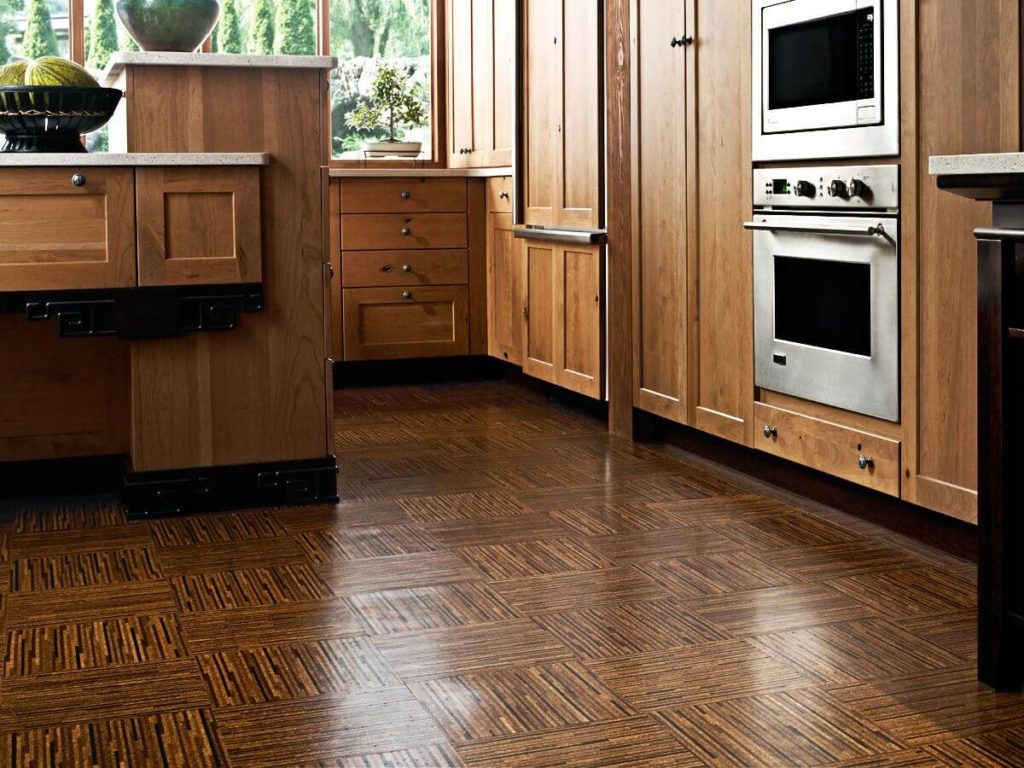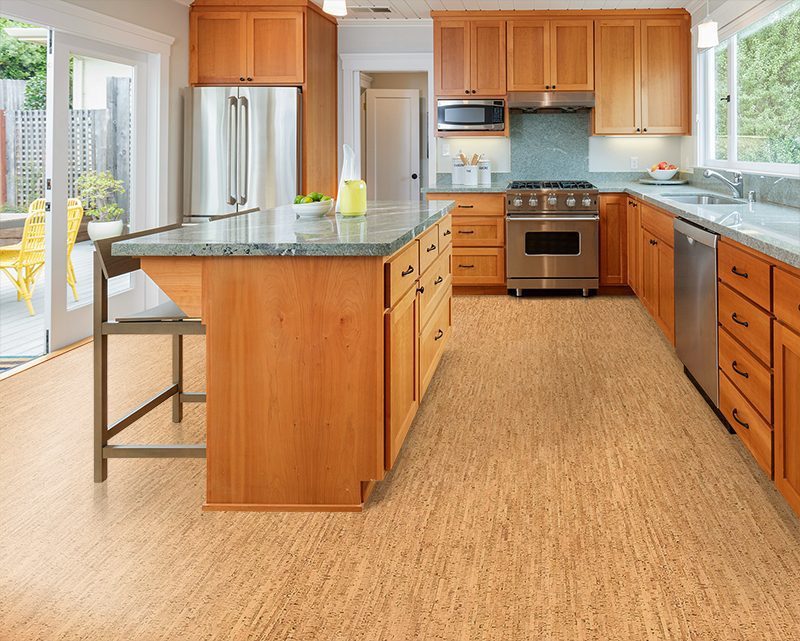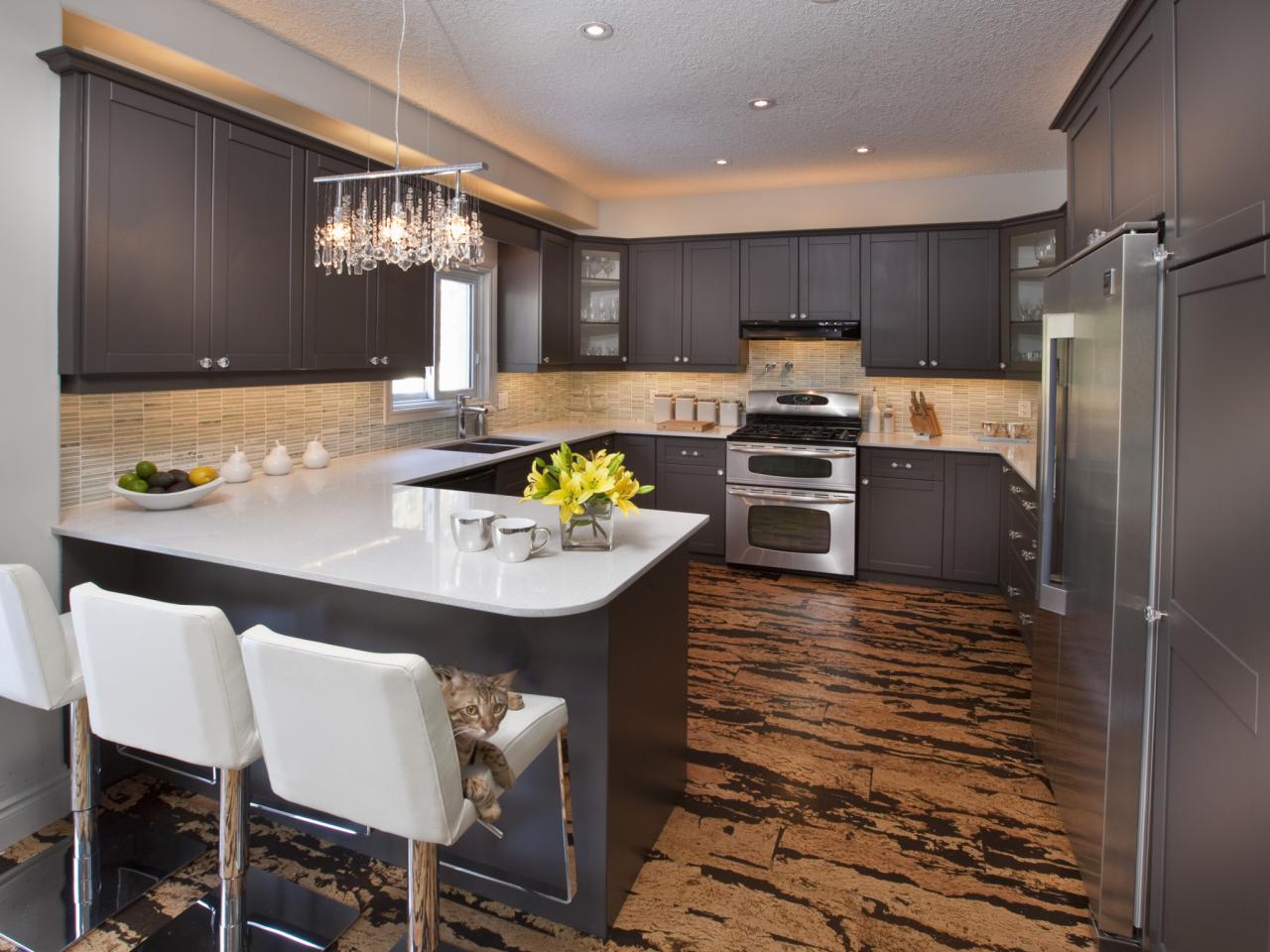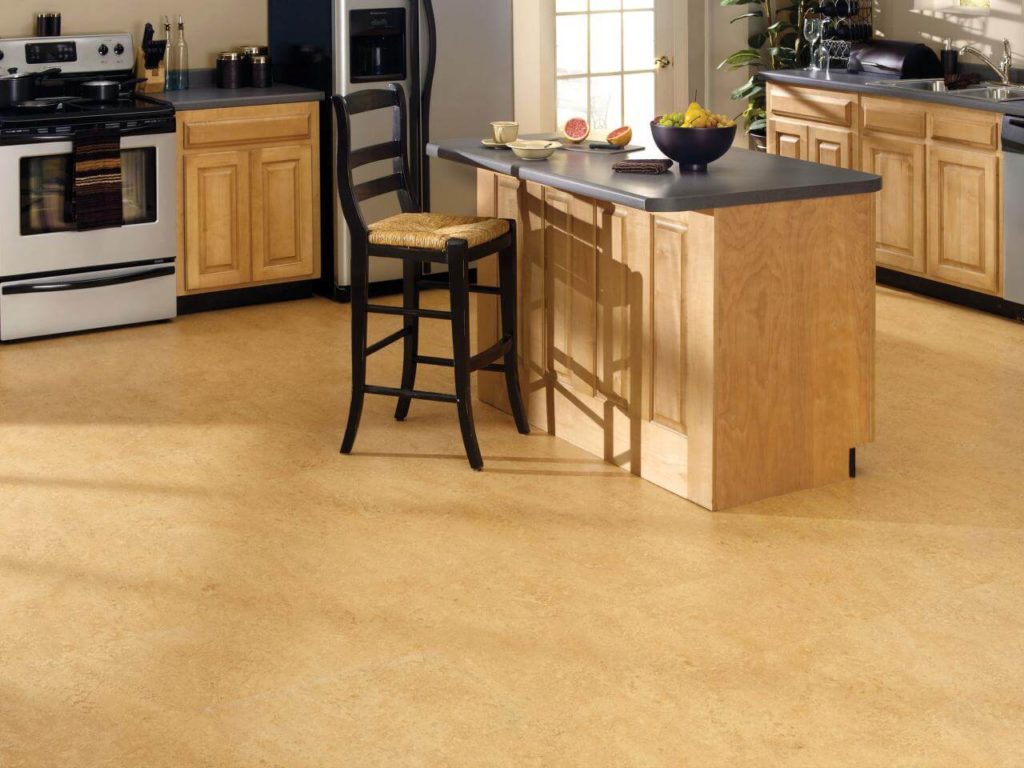Cork flooring has gained popularity in recent years, particularly in kitchens, due to its unique combination of sustainability, comfort, and aesthetic appeal. Let’s explore the benefits of cork flooring, its installation and maintenance requirements, design options, and considerations for use in kitchen environments. Additionally, we will address common mistakes to avoid and provide answers to frequently asked questions about cork flooring in kitchens.
Benefits of Cork Flooring in Kitchens
Sustainability and Eco-Friendliness
Cork flooring is an eco-friendly option, making it an excellent choice for environmentally-conscious homeowners. Cork is harvested from the bark of the cork oak tree, which regenerates after harvesting. This sustainable process ensures that trees are not cut down, allowing them to continue to grow and absorb carbon dioxide, contributing to environmental conservation.
Additionally, cork production generates minimal waste, as even the remnants from manufacturing are utilized in other products. The renewable nature of cork, combined with its biodegradability, makes it a green alternative to conventional flooring materials such as vinyl or laminate, which often contain harmful chemicals and are not easily recyclable.
Comfort and Insulation
One of the standout features of cork flooring is its comfort underfoot. Cork’s natural cellular structure provides a cushiony surface that is gentle on the feet and joints, making it an ideal choice for kitchens where people often stand for extended periods. This comfort can reduce fatigue and improve the overall experience of working in the kitchen.
Cork also offers excellent thermal and acoustic insulation. Its insulating properties help maintain a consistent temperature in the kitchen, making it warmer in the winter and cooler in the summer. Furthermore, cork’s ability to absorb sound reduces noise levels, creating a quieter and more pleasant kitchen environment.
Durability and Resilience
Cork flooring is surprisingly durable and resilient, able to withstand the wear and tear of a busy kitchen. Its unique cellular structure allows it to compress and bounce back, making it resistant to dents and impacts from dropped utensils or heavy appliances. This resilience helps maintain the floor’s appearance and integrity over time.
Additionally, cork is naturally resistant to moisture and mold, which is crucial for kitchen environments where spills and humidity are common. Many cork flooring products come with a protective finish that enhances their water resistance and makes them easier to clean and maintain.
Aesthetic Versatility
Cork flooring offers a wide range of design options, allowing homeowners to achieve various looks to complement their kitchen decor. Available in a variety of colors, patterns, and textures, cork can mimic the appearance of hardwood, stone, or even tile, providing a versatile aesthetic appeal.
The natural variations in cork’s grain patterns add visual interest and a unique character to each installation. Whether you prefer a modern, rustic, or traditional kitchen design, cork flooring can be customized to suit your style preferences and create a cohesive and attractive look.

Installation and Maintenance
Preparation and Installation
Proper preparation is essential for a successful cork flooring installation in the kitchen. Start by ensuring the subfloor is clean, dry, and level. Remove any old flooring materials and repair any damage to the subfloor. It’s also crucial to acclimate the cork tiles or planks to the kitchen environment for at least 48 hours before installation to account for any expansion or contraction.
Cork flooring can be installed using various methods, including glue-down, floating, and click-together systems. The glue-down method involves adhering the cork tiles directly to the subfloor, providing a stable and durable surface. Floating and click-together systems are more straightforward, with the cork planks interlocking without the need for adhesives, making them easier to install for DIY enthusiasts.
Sealing and Finishing
Sealing cork flooring is an essential step to enhance its durability and moisture resistance, particularly in kitchens. Many cork flooring products come pre-finished with a protective sealant, but additional coats of sealant may be necessary after installation. Polyurethane sealants are commonly used for cork floors, providing a clear, durable finish that protects against spills and stains.
When applying sealant, follow the manufacturer’s instructions carefully, ensuring even coverage and allowing sufficient drying time between coats. A well-sealed cork floor will be easier to clean and maintain, prolonging its lifespan and preserving its appearance.
Cleaning and Maintenance
Maintaining cork flooring in the kitchen involves regular cleaning and prompt attention to spills. Sweep or vacuum the floor regularly to remove dirt and debris that can scratch the surface. Use a damp mop with a pH-neutral cleaner for more thorough cleaning, avoiding harsh chemicals or abrasive tools that can damage the finish.
Address spills immediately by blotting with a clean cloth to prevent moisture from penetrating the cork. For stubborn stains, use a mild cleaner and gently scrub the area with a soft-bristle brush. Periodically inspect the floor for signs of wear or damage and apply additional coats of sealant as needed to maintain its protective barrier.
Long-Term Care
Proper long-term care ensures the longevity and appearance of cork flooring in the kitchen. Place mats or rugs in high-traffic areas and near sinks to protect the floor from excessive wear and moisture. Use furniture pads or coasters under heavy appliances and furniture to prevent dents and scratches.
Avoid prolonged exposure to direct sunlight, which can cause the cork to fade or discolor. Consider using window coverings or UV-protective film on windows to minimize sunlight exposure. With proper care and maintenance, cork flooring can provide a durable and attractive surface for many years.
Design Options and Aesthetic Appeal
Color and Pattern Choices
Cork flooring comes in a wide range of colors and patterns, allowing homeowners to create various looks to complement their kitchen decor. Natural cork hues range from light beige to deep brown, with subtle variations in grain patterns that add visual interest. These natural tones can create a warm and inviting kitchen atmosphere.
For those seeking a more contemporary or unique look, cork flooring is also available in stained or dyed options. Bold colors like red, blue, or green can make a statement, while softer pastels can add a touch of elegance. Patterned cork tiles, such as those mimicking the appearance of wood planks or stone tiles, offer additional design flexibility.
Textured and Smooth Finishes
Cork flooring is available in both textured and smooth finishes, each offering distinct aesthetic and functional benefits. Textured cork surfaces provide a more rustic and natural look, with the added advantage of being less slippery, which is beneficial in a kitchen setting. The texture can also help hide minor scratches and wear, maintaining the floor’s appearance over time.
Smooth cork finishes, on the other hand, offer a sleek and modern look that can enhance a contemporary kitchen design. These finishes are easy to clean and maintain, providing a seamless surface that complements various decor styles. Both textured and smooth cork floors can be sealed to enhance their durability and water resistance.
Customization and Artistic Designs
Cork flooring can be customized to create unique and artistic designs, adding a personal touch to your kitchen. Custom inlays, borders, or patterns can be incorporated into the floor design, creating a focal point or accentuating specific areas of the kitchen. This level of customization allows homeowners to express their creativity and make their kitchen truly one-of-a-kind.
In addition to custom designs, cork tiles can be arranged in various patterns, such as herringbone, diagonal, or checkerboard, to add visual interest and depth to the floor. These patterns can be tailored to suit the overall design theme of the kitchen, enhancing its aesthetic appeal.
Compatibility with Kitchen Styles
Cork flooring is versatile and compatible with various kitchen styles, from traditional to modern. Its natural warmth and texture complement rustic and farmhouse kitchens, while its sleek and smooth finishes are ideal for contemporary and minimalist designs. The wide range of colors and patterns available ensures that cork flooring can seamlessly integrate into any kitchen decor.
For traditional kitchens, natural cork tones and classic patterns can create a timeless and elegant look. In modern kitchens, bold colors and unique patterns can make a striking statement. Cork’s adaptability makes it a popular choice for homeowners looking to enhance their kitchen’s aesthetic appeal while enjoying its practical benefits.
Considerations for Use in Kitchens
Moisture and Water Resistance
While cork is naturally resistant to moisture, it is not entirely waterproof. In a kitchen environment where spills and humidity are common, it’s essential to ensure the cork flooring is adequately sealed to prevent water damage. Proper sealing creates a protective barrier that enhances the floor’s resistance to moisture and stains.
Regularly inspect the sealant and reapply it as needed to maintain its effectiveness. Avoid standing water on the floor and promptly clean up any spills to prevent them from seeping into the cork. With proper care and maintenance, cork flooring can perform well in kitchen environments despite its sensitivity to moisture.
Durability and Wear Resistance
Cork flooring is durable and resilient, but its performance in high-traffic kitchen areas depends on proper care and maintenance. Use mats or rugs in high-traffic areas and near sinks to protect the floor from excessive wear. These protective measures can help distribute the weight and reduce the impact on the floor, prolonging its lifespan.
Regular cleaning and prompt attention to spills are crucial to maintaining the floor’s appearance and durability. Avoid using harsh chemicals or abrasive tools that can damage the cork’s surface. With proper care, cork flooring can withstand the demands of a busy kitchen and remain attractive for many years.
Cost and Budget Considerations
Cork flooring is generally more affordable than other sustainable flooring options, such as hardwood or natural stone. However, the cost can vary depending on the quality, design, and installation method. Glue-down cork tiles are typically more cost-effective, while click-together systems and custom designs may come at a higher price.
When budgeting for cork flooring, consider the long-term savings in maintenance and energy efficiency due to its insulating properties. Additionally, factor in the cost of sealants and periodic maintenance to ensure the floor remains in optimal condition. Cork flooring offers a balance of affordability and performance, making it a practical choice for many homeowners.
Health and Safety Benefits
Cork flooring offers several health and safety benefits, making it a suitable choice for kitchens. Its natural antimicrobial properties help reduce the growth of mold, mildew, and bacteria, contributing to a healthier kitchen environment. Cork is also hypoallergenic, making it an excellent option for households with allergy sufferers.
Additionally, the cork’s softness and resilience provide a safer surface in the event of slips and falls, reducing the risk of injuries. The cushioning effect of cork can also be beneficial for people with joint issues, providing a more comfortable surface to stand on for extended periods. These health and safety benefits enhance the overall appeal of cork flooring in kitchens.
Common Mistakes to Avoid
Neglecting Proper Sealing
Failing to properly seal cork flooring can lead to water damage, staining, and reduced durability. Ensure the floor is adequately sealed during installation and reapply sealant as needed to maintain its protective barrier. Neglecting this step can compromise the floor’s performance and appearance over time.
Using Harsh Cleaning Chemicals
Using harsh cleaning chemicals can damage the cork’s surface and protective sealant. Avoid bleach, ammonia, and other abrasive cleaners. Instead, use pH-neutral cleaners specifically designed for cork flooring to preserve its integrity and appearance.
Ignoring Spills and Moisture
Ignoring spills and moisture can lead to staining and water damage. Promptly clean up any spills and avoid leaving standing water on the floor. Regularly check for signs of moisture damage and address any issues immediately to prevent long-term problems.
Skipping Regular Maintenance
Skipping regular maintenance can result in dirt buildup, surface damage, and reduced longevity of the cork flooring. Establish a consistent cleaning routine, including sweeping, mopping, and periodic resealing, to keep the floor in good condition and extend its lifespan.
Is cork flooring suitable for kitchens?
Yes, cork flooring is suitable for kitchens due to its comfort, durability, and resistance to moisture and mold. Proper sealing and maintenance are essential to ensure its performance in a kitchen environment.
How do I clean and maintain cork flooring in the kitchen?
Regularly sweep or vacuum to remove dirt and debris. Use a damp mop with a pH-neutral cleaner for thorough cleaning. Promptly clean up spills and avoid using harsh chemicals or abrasive tools. Periodically inspect and reseal the floor as needed.
Can cork flooring withstand high-traffic areas in the kitchen?
Cork flooring is durable and resilient, making it suitable for high-traffic areas. Use mats or rugs in high-traffic zones and near sinks to protect the floor from excessive wear. Regular maintenance helps preserve its appearance and durability.
How do I protect cork flooring from water damage?
Ensure the cork flooring is adequately sealed during installation and reapply sealant as needed. Promptly clean up spills and avoid standing water. Use mats or rugs in areas prone to moisture to provide additional protection.
What are the benefits of cork flooring in the kitchen compared to other flooring options?
Cork flooring offers several benefits, including sustainability, comfort, thermal and acoustic insulation, and aesthetic versatility. It is durable, resilient, and resistant to moisture and mold, making it a practical and attractive choice for kitchens. Its eco-friendly nature and health benefits further enhance its appeal compared to other flooring options.
Cork Flooring Durability Kitchen – Flooring Site
Cork Flooring In Kitchens
The Definitive Guide to Cork Flooring DIY
Cork Flooring In Kitchens
Cork Flooring For Kitchen
Cork Flooring For Kitchens
Best Kid-Friendly Kitchen Flooring Options
Cork Flooring – Best Cork Floor Tiles for Kitchen – The Architecture Designs
Maximizing Cork Flooring for Kitchen, Cork Flooring Kitchen Pros and Cons
Why OSB is a hidden winner for your home homify Cork flooring kitchen, Kitchen flooring
Kitchen with cork flooring Cork flooring, Kitchen flooring, Slate appliances
Related Posts:













